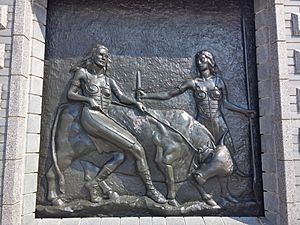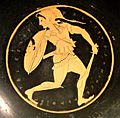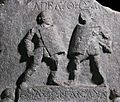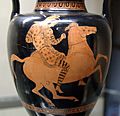Amazons facts for kids
- For other uses, see Amazon
In Greek mythology, the Amazons were a tribe of warrior women believed to live in Asia Minor. Apollonius Rhodius, in his Argonautica, mentions that the Amazons were the daughters of Ares and Harmonia (a nymph of the Akmonian Wood), that they were brutal and aggressive, and their main concern in life was war.
Herodotus and Strabo place them on the banks of the Thermodon River. According to Diodorus, giving the account of Dionysius of Mitylene, the Amazons inhabited Ancient Libya long before they settled along the Thermodon. Migrating from Libya, these Amazons passed through Egypt and Syria, and stopped at the Caïcus in Aeolis, near which they founded several cities.
Later, Diodorus maintains, they established Mytilene a little way beyond the Caïcus. Aeschylus, in Prometheus Bound, places the original home of the Amazons in the country about Lake Maeotis, and from which they moved to Themiscyra on the Thermodon. Homer tells that the Amazons were sought and found somewhere near Lycia.
Notable queens of the Amazons are Penthesilea, who participated in the Trojan War, and her sister Hippolyta, whose magical girdle, given to her by her father Ares, was the object of one of the labours of Heracles. The Amazons fought on the side of Troy against the Greeks during the Trojan War.
Archaeological discoveries of burial sites with female warriors on the Eurasian Steppes suggest that the Scythian women may have inspired the Amazon myth. From the early modern period, their name has become a term for female warriors in general.
Amazons were said to have founded the cities and temples of Smyrna, Sinope, Cyme, Gryne, Ephesus, Pitania, Magnesia, Clete, Pygela, Latoreria and Amastris; according to legend, the Amazons also invented the cavalry.

According to ancient sources (Plutarch, Theseus, Pausanias), Amazon tombs could be found frequently throughout what was once known as the ancient Greek world. Some are found in Megara, Athens, Chaeronea, Chalcis, Thessaly at Skotousa, in Cynoscephalae, and statues of Amazons are all over Greece.
The city of Samsun in modern-day Turkey features a recently constructed "Amazon Village" museum, created to bring attention to the legacy of the Amazons and to generate both academic interest and popular tourism. A festival is also held every year in the Terme district of Samsun Province to celebrate the Amazons.
In Greece, female equestrians are also called "Amazons"
Images for kids
-
A Greek fighting an Amazon. Detail from painted sarcophagus found in Italy, 350-325 BC
-
Departure of the Amazons, by Claude Deruet 1620, Metropolitan Museum of Art, New York
-
Battle of the Amazons, by Peter Paul Rubens, 1618, Alte Pinakothek, Munich
-
An amazon fighter statue in Terme, Turkey
-
A Tyrrhenian amphora, depicting an Amazonomachy - Hercules fights Andromache, Telamon fights Ainipe and Iphis fights Panariste, ca. 570 BC, Museum of Fine Arts, Boston
-
The Amazon Queen Thalestris in the camp of Alexander the Great, Johann Georg Platzer
-
A hippeis rider seizes a mounted Amazonian warrior armed with a labrys by her Phrygian cap. Roman mosaic emblema (marble and limestone) from Daphne, a suburb of Antioch-on-the-Orontes (now Antakya in Turkey), second half of the 4th century AD, the Louvre, Paris
-
Francisco de Orellana, coined the name Amazon River
See also
 In Spanish: Amazonas (mitología) para niños
In Spanish: Amazonas (mitología) para niños


















